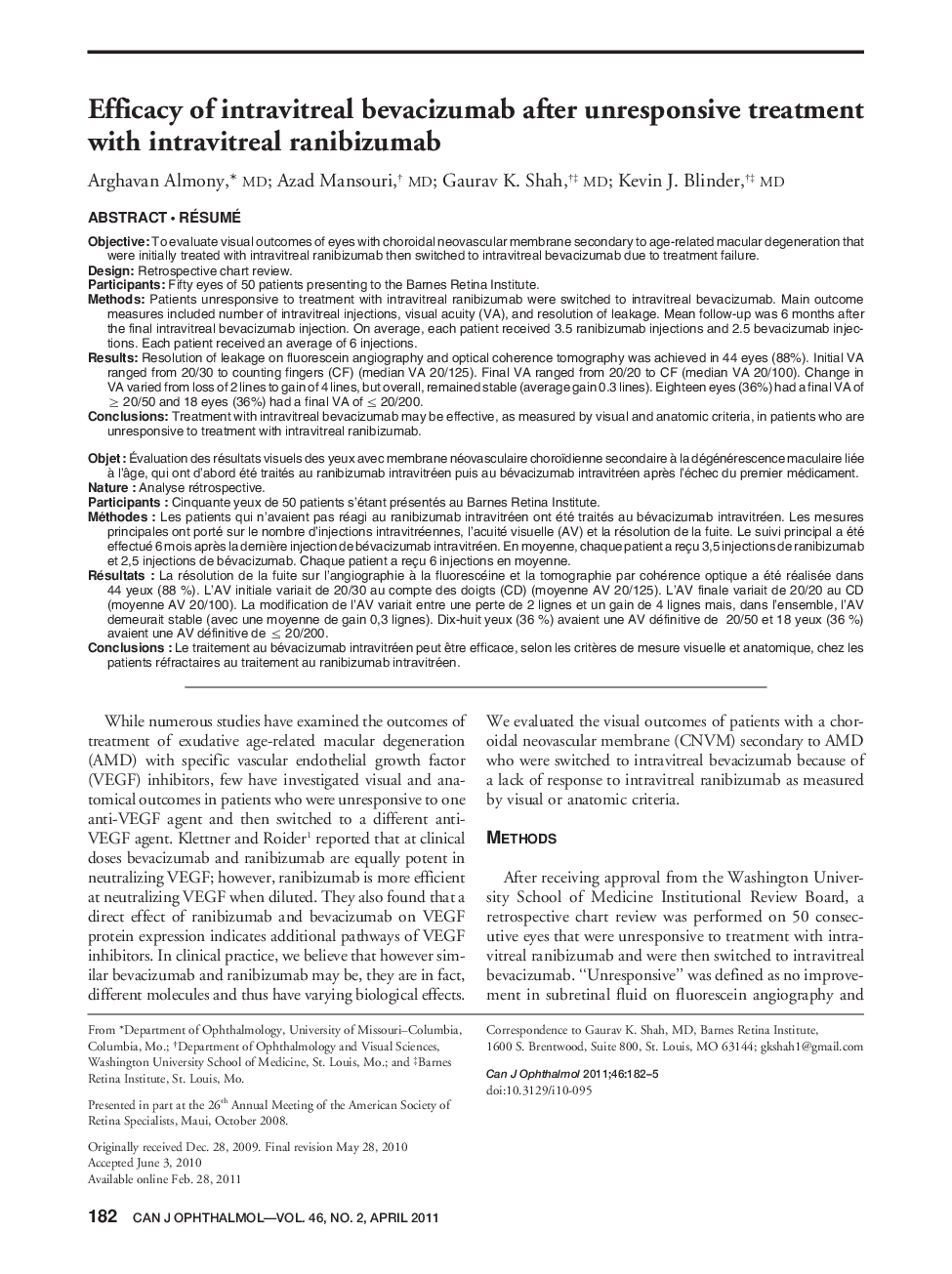| کد مقاله | کد نشریه | سال انتشار | مقاله انگلیسی | نسخه تمام متن |
|---|---|---|---|---|
| 4009706 | 1602424 | 2011 | 4 صفحه PDF | دانلود رایگان |

Objective: To evaluate visual outcomes of eyes with choroidal neovascular membrane secondary to age-related macular degeneration that were initially treated with intravitreal ranibizumab then switched to intravitreal bevacizumab due to treatment failure.Design: Retrospective chart review.Participants: Fifty eyes of 50 patients presenting to the Barnes Retina Institute.Methods: Patients unresponsive to treatment with intravitreal ranibizumab were switched to intravitreal bevacizumab. Main outcome measures included number of intravitreal injections, visual acuity (VA), and resolution of leakage. Mean follow-up was 6 months after the final intravitreal bevacizumab injection. On average, each patient received 3.5 ranibizumab injections and 2.5 bevacizumab injections. Each patient received an average of 6 injections.Results: Resolution of leakage on fluorescein angiography and optical coherence tomography was achieved in 44 eyes (88%). Initial VA ranged from 20/30 to counting fingers (CF) (median VA 20/125). Final VA ranged from 20/20 to CF (median VA 20/100). Change in VA varied from loss of 2 lines to gain of 4 lines, but overall, remained stable (average gain 0.3 lines). Eighteen eyes (36%) had afinal VA of ≥ 20/50 and 18 eyes (36%) had a final VA of ≤ 20/200.Conclusions: Treatment with intravitreal bevacizumab may be effective, as measured by visual and anatomic criteria, in patients who are unresponsive to treatment with intravitreal ranibizumab.
RésuméObjet: Évaluation des résultats visuels des yeux avec membrane néovasculaire choroïdienne secondaire à la dégénérescence maculaire liée à l’age, qui ont d’abord été traités au ranibizumab intravitrén puis au bévacizumab intravitréen après l’echec du premier médicament.Nature: Analyse rétrospective.Participants: Cinquante yeux de 50 patients s’étant présentés au Barnes Retina Institute.Méthodes: Les patients qui n’avaient pas réagi au ranibizumab intravitrén ont été traités au bévacizumab intravitréen. Les mesures principales ont porté sur le nombre d’injections intravitréennes, l’acuité visuelle (AV) et la résolution de la fuite. Le suivi principal a été effectué 6 mois après la dernière injection de bévacizumab intravitréen. En moyenne, chaque patient a reçu 3,5 injections de ranibizumab et 2,5 injections de bévacizumab. Chaque patient a reçu 6 injections en moyenne.Résultats: La résolution de la fuite sur l’angiographie à la fluorescéine et la tomographie par cohérence optique a été réalisée dans 44 yeux (88 %). L’AV initiale variait de 20/30 au compte des doigts (CD) (moyenne AV 20/125). L’AV finale variait de 20/20 au CD (moyenne AV 20/100). La modification de l’AV variait entre une perte de 2 lignes et un gain de 4 lignes mais, dans l’ensemble, l’AV demeurait stable (avec une moyenne de gain 0,3 lignes). Dix-huit yeux (36 %) avaient une AV définitive de 20/50 et 18 yeux (36 %) avaient une AV définitive de ≤ 20/200.Conclusions: Le traitement au bévacizumab intravitréen peut être efficace, selon les critères de mesure visuelle et anatomique, chez les patients réfractaires au traitement au ranibizumab intravitréen.
Journal: Canadian Journal of Ophthalmology / Journal Canadien d'Ophtalmologie - Volume 46, Issue 2, April 2011, Pages 182-185